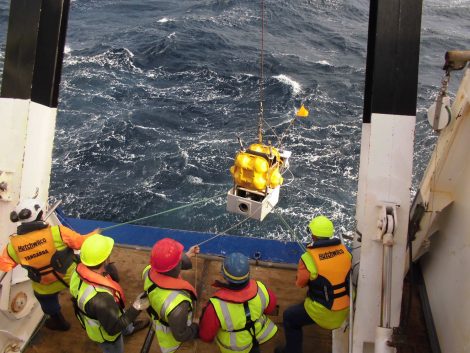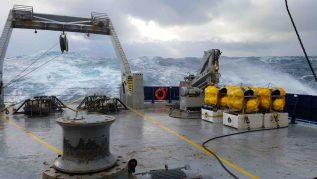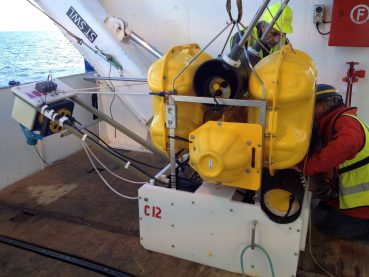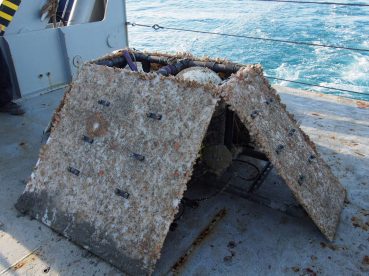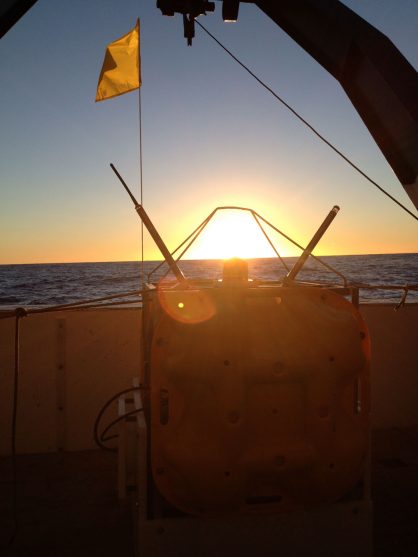Erin K. Todd (University of California Santa Cruz) on behalf of the HOBITSS experiment team
The Hikurangi Ocean Bottom Investigation of Tremor and Slow Slip (HOBITSS) experiment is a multi-national collaborative offshore seismic and geodetic research project that explores the relationship between slow slip events (SSEs), tectonic tremor, and seismicity along the shallowest part of the northern Hikurangi Margin where the Pacific Plate is subducting beneath the North Island of New Zealand. An array of 24 absolute pressure gauges (APG), fifteen ocean bottom seismometers (OBS), and three ocean bottom electromagnetometers were deployed between the shoreline and the trench for thirteen months to capture deformation, seismicity, and conductivity changes during large SSEs offshore the North Island’s east coast.
This offshore Gisborne region hosts shallow SSEs (<15 km depth) approximately every eighteen months that typically last from one to three weeks and release energy equivalent to Mw 6.5-6.8 earthquakes. However, to capture vertical deformation with the seafloor pressure sensors, the network needed to be in place during one of the larger SSEs, which only occur every four to six years. With the last very large SSE in the Gisborne region in March/April 2010, choosing the correct time for the deployment was definitely a gamble, as the timing of the large north Hikurangi SSEs is not particularly predictable! Thankfully, the anticipated SSE began in late September 2014 directly beneath the HOBITSS array (Fig. 1). The September 2014 SSE was the second-largest SSE observed on that part of the subduction zone, so we were incredibly lucky to have the seafloor instruments in place at just the right time.
Between the deployment and recovery expeditions, the science party consisted of researchers from the United States, Japan, and New Zealand, marine geophysical instrument engineers from the United States and Japan, and ten graduate students from the United States, Japan, and New Zealand. The experiment was funded by NSF Marine Geology and Geophysics in addition to Japanese and New Zealand funding agencies. These expeditions were the first seagoing experience for many of the graduate students, myself included.
May 2014 – The Deployment
New Zealand’s Research Vessel Tangaroa was used for the deployment cruise. We set out from Wellington and began the 24-hour journey to our deployment site. Those 24 hours were very busy as the engineers began checking over every component of the instruments to ensure they were ready for deployment. As a graduate student on my first scientific cruise, I spent the first day learning my way around the ship, adjusting to ship life, and meeting all the members of the science and engineering parties. While a couple of the grad students had been on scientific cruises before, the rest of us had never been to sea before and didn’t know what would be expected of us or how we would fit in to the deployment procedure. Thankfully, everyone in the science and engineering parties was extremely helpful and, by the time we reached the deployment site, we all knew what to do.
Once the deployment began, the mood on the ship changed. Everyone was focused on the task at hand. The first day of deployment was a whirlwind as we deployed fourteen instruments and recovered four that had been deployed the previous year as part of another experiment. Each step in the deployment procedure was well executed and it was fascinating to watch the exchanges between the leaders of the science party and the engineers as they worked together to determine which instrument would be ready for deployment next, how long it would take to transit to the deployment location, and how long it would take to survey the deployed instruments to pinpoint their final location (Fig. 2). So many moving pieces and steps needed to be completed in the correct order to successfully deploy the instruments with the time and resources available. Prior to the cruise, I had assumed that certain elements of the experiment like the order of station deployment had been pre-determined. I was surprised at the number of decisions that had to be made at the time of deployment based on the immediate resources and weather conditions. Once I was on the ship, I realized how quickly something could happen to change any pre-determined plans.
We were fortunate enough to have good weather for the first few days, but by day 4, the weather took a turn for the worse. Three days into the cruise, we had deployed 24 stations and seemed to be ahead of schedule, but our good fortune came to a swift end when a storm arrived early on the fourth day forcing us to hold position through the storm for 36 hours. With strong winds and heavy swells, deploying new instruments and surveying the locations of previously deployed instruments was out of the question. While some of the grad students had been to sea before, others of us had not and discovered if we were prone to seasickness or not. I was lucky enough to not get seasick, but for others, the storm brought some real challenges. Fortunately, everyone helped each other out to ensure that all essential tasks were covered. Calm weather returned for the last few days of the cruise and we were finally able to deploy the remaining instruments before turning back for Wellington Harbor.
“I learned that if you are going to take sea-sickness medication, it should be well before the research vessel leaves the dock. Preventative measures are key. I learned a lot on the HOBITSS deployment cruise, especially what goes into determining simple parameters that data analysts and grad students like myself take for granted, for instance, the latitude, longitude, and depth of the instrument. Ocean bottom instrument deployment can be more complicated than land deployment, and it was enlightening to see the Principal Investigators work to figure out the next deployment site and manage the experiment. It was good experience to help with the cruise report and determine locations of instruments, as well as learn how to ping the instruments as they sunk to the ocean floor. My advisor arranged a series of science talks on the deployment, so I learned a lot about the context of the experiment, which is really helpful because I will be working with the data. I appreciated the opportunity to meet and work with a variety of scientists from Lamont-Doherty Earth Observatory, the Earthquake Research Institute in Tokyo, Japan, Tohoku University, University of Texas Austin, University of California Santa Cruz, and New Zealand. We had a very international team!”
– Jenny Nakai, Graduate Student, University of Colorado Boulder
“The HOBBITS cruise was quite an unique experience for me. Unlike previous cruises I participated to learn and observe as a student, on the HOBBITS deployment cruise I worked as part of the OBS technical team. My main responsibility was to assemble and service ocean bottom seismometers and pressure gauges to get them ready for a yearlong deployment.
Working together with the OBS team on the deck on a nut and bolt level make me realize the amount of work and level of dedication that goes into deploying each OBS. For example, in order to make sure that the instrument can return to the surface following an acoustic command, two redundant release systems are put in place, both equipped with two sets of redundant wiring. Only one of the four needs to work properly for the system to function, but all four systems need to be quadruple-checked before deployment. Given the harsh environment at the sea floor, we can’t take any chances.”
– Yang Zha, former Graduate Student, LDEO, Columbia University
June 2015 – The Recovery
From the perspective of those of us who had never been on an OBS recovery cruise, the idea of successfully recovering 35 instruments that had been sitting on the ocean floor for thirteen months, accumulating sediment and marine life, seemed daunting. We knew the main Gisborne slow slip event under the array had occurred four months into the deployment and a second slow slip event had been recorded to the south of the array, so there was a lot of anticipation and the Principal Investigators were very eager to get a look at the data.
The United States’ Research Vessel Roger Revelle was used for the instrument recovery cruise. This time, the expedition began and ended in Napier, which is a famous “Art Deco” city on the New Zealand’s east coast. Most of Napier was destroyed in an earthquake in 1931 and was completely rebuilt right after that in the Art Deco style of the time. Napier is very close to the HOBITSS experiment location, so the transit to retrieve our instruments was shorter than for the deployment.
There was a lot of nervous excitement among the team as we arrived on site and prepared to recover the first instrument. What if the instrument was buried by sediment? What if the receiver on the instrument didn’t recognize the release command? What if marine life or sediment had damaged the instrument in some way and it didn’t float back to the surface? What if the battery died during the deployment? What if the pressure case leaked and the instruments were exposed to seawater? The seafloor is a harsh environment for sensitive electronics and there were many things that could have gone wrong.
After the first instrument was brought on board, the tense mood that had gripped the team relaxed and we started to recover instruments in earnest. The seas were calm and the winds were light for the first full day of recovery and nine instruments were recovered. Recovering instruments is a tricky process – even if everything works and the instrument rises to the surface, there are still challenges to getting it on board. As the ship arrives on site, we use the ship’s hull-mounted transducer to communicate with the instrument and send the correct signal for the instrument to release its weights and start rising toward the surface. Depending on the ocean depth, the ascent can take over an hour. During that hour, the ship and instrument communicate back and forth to track the progress of the ascent. Once it is clear that the instrument has reached the surface, we would send out spotters all over the ship to look for the instrument bobbing on the surface. Some of the instruments have small flags attached because when they rise off the ocean floor they would float just below the surface and it would be difficult to locate them without the small pennant flag. As the instrument is spotted, the captain would maneuver the ship alongside it. The technicians and engineers would then use long poles equipped with hooks on the end to grab the instrument and hook it up to the winch to pull it out of the water. Each step requires numerous people doing their part carefully and at exactly the right time.
We were keeping an eye on a storm that was heading our way, threatening to reach us in the middle of the cruise, so we worked quickly to recover as many instruments as possible before the seas got too rough. As the storm hit, we were forced to suspend recovery operations due to high winds and large swells. On one of my shifts, we hit a particularly large swell and everything that wasn’t strapped down went sailing across the room. Chairs toppled over, notebooks and papers went sliding, and a large telephone fell of the table. Thankfully, after one or two stormy days, we were able to resume operations and recover the rest of the instruments. We successfully recovered 34 of 35 instruments: after many attempts over a few days, one of the ocean bottom electromagnetometers was considered lost after it never acknowledged the communication from the ship.
Most of our instruments were deep water (over a thousand meter depth), but five of them were on the shelf, less than one hundred meters water depth. One of the complications with having instruments at such shallow depths is that they quickly accumulate a lot of marine life (Fig. 3). In order to pass the agricultural inspection once back to port, all the instruments had to be thoroughly cleaned of any traces of mud, plant life, or animal life.
Cleaning these instruments became a large part of the graduate students’ jobs during the second half of the cruise. Soft- and hard-bodied organisms, coating every inch of the instruments, had to be removed. The task was messy and smelly but very critical, as we would not have been allowed to re-enter New Zealand with dirty instruments. As we arrived back in to port and the agricultural inspector came on board to check the instruments, they found a small patch of mud about the size of your palm deep in the inside of one of the instruments that had to be cleaned with alcohol and paper towels and placed into a quarantine bag. After cleaning the remaining mud off the instrument, we were given the all clear!
Hard won results
All the hard work to deploy and recover the instruments really paid off in the end! The Absolute Pressure Gauge data showed that the SSE in September 2014 produced a clearly observed 2-7 cm of vertical deformation of the seafloor (Wallace et al., 2016), much more than any of us ever expected. The vertical deformation shows that slow slip occurred to within at least 2 km of the seafloor, and it is possible that slip went all the way to the trench (Fig. 1). The HOBITSS results really help to demonstrate that Absolute Pressure Gauges are a valuable tool for monitoring centimeter-level offshore tectonic deformation. In addition, preliminary results from the seismic data show the existence of tectonic tremor during the slow slip and that the previously observed seismicity increase during the last large Gisborne SSE in 2010 is also present for the 2014 SSE in similar locations (Todd et al. in prep).
Future Projects – 2017 & 2018
In addition to the HOBITSS experiment, there are a number of exciting future projects slated for the Hikurangi subduction margin in the coming years. The shallow nature of these slow slip events will be the target of IODP drilling in 2017 and 2018 (Expeditions 372 and 375), to better understand the physical origins of slow slip and to install borehole observatories to do near-field monitoring. In addition to the drilling experiment, the R/V Marcus Langseth will undertake an NSF-funded 3D seismic survey in early 2018 to image the shallow slow slip source area. Being able to tie the HOBITSS experiment results in with the results of co-located IODP drilling and 3D seismic imaging will be very exciting! ■

“Report from the Field” was designed to inform the community of real-time, exciting GeoPRISMS -related research. Through this report, the authors expose the excitement, trials, and opportunities to conduct fieldwork, as well as the challenges they may have experienced by deploying research activities in unique geological settings. If you would like to contribute to this series and share your experience on the field, please contact the GeoPRISMS Office at info@geoprisms.nineplanetsllc.com. This opportunity is open to anyone engaged in GeoPRISMS research, from senior researchers to undergraduate students.
We hope to hear from you!


